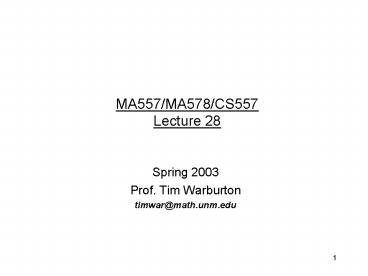Spring 2003 PowerPoint PPT Presentation
1 / 32
Title: Spring 2003
1
MA557/MA578/CS557Lecture 28
- Spring 2003
- Prof. Tim Warburton
- timwar_at_math.unm.edu
2
Linear Systems of 2D PDEs
- A general linear pde system will look like
3
Deriving DG
- Ok by popular demand heres a brief derivation
of the DG scheme for advection.
1
2
4
3
4
5
5
Necessary condition on qhat for stability
6
5 cont
6
7
Proof of possible solution
8
Upwinding Unveiled
This is nothing more than upwinding in disguise
9
Equivalent Conditions
10
Returning To DG Scheme
11
Convergence
- Convergence follows as beforehowever for a given
choice of qhat we need to verify consistency to
guarantee stability. - In fact for the convergence result to hold we
required the truncation error to vanish in the
limit of small h and also large p. - For example we required
- This is easily verified for the choice of qhat we
just made.
12
General Choice of qhat
- We established the following sufficient
conditions on the choice of the function
qhat(q,q-) - As long as these are met for a choice of qhat
then the scheme will be stable. - However, the choice of qhat may impact accuracy
13
An Alternative Construction for qhat
- Exercise prove that this is a sufficient
condition for stability. i.e. - This generates the Lax-Friedrich flux based DG
scheme
14
Lax-Friedrichs Fluxes
- Suppose we know the maximum wave speed of the
hyperbolic system - As long as the matrix
are codiagonalizable for any linear combination. - i.e. Has real
eigenvalues for any real alpha,beta. - And
- then we can use the following DG scheme
15
Lax-Friedrichs DG Scheme For Linear Systems
As before we can generalize the scalar PDE
scheme to a system
16
Discrete LF/DG Scheme
- We choose to discretize the Pp polynomial space
on each triangle using M(p1)(p2)/2 Lagrange
interpolatory polynomials. - i.e.
- The scheme now reads
17
Tensor Form
18
Simplified Tensor Form
19
Geometric Factors
- We use the chain rule to compute the Dx and Dy
matrices - In the umSCALAR2d scripts the
20
Surface Terms
- In the Matlab code first we extract the nodes on
the edges of the elements - fC umFtoNC
- The resulting matrix fC has dimension
(umNfaces(umP1))xumNel - This lists all nodes from element 1, edge 1 then
element 1, edge 2 then - In order to multiply, say fC, by Se we use
umNtoF(Fscale.fC) where Fscale
sjac./(umNtoFjac)
21
Example Matlab Code(Upwind DG Advection Scalar
Eqn)
- This is not strictly a global Lax-Friedrichs
scheme since the lambda is chosen locally!!!
22
Example Matlab Code cont
23
Specific Example
- We will try out this scheme on the 2D, transverse
mode, Maxwells equations.
24
Maxwells Equations (TM mode)
- In the absence of sources, Maxwells equations
are - Where
25
Free Space..
- For simplicity we will assume that the
permeability and permittivity are 1 we then
obtain
26
Divergence Condition
- We next notice that by taking the x derivative of
the first equation and the y derivative of the
second equation we find that - i.e. the fourth equation (divergence condition)
is a natural result of the equations assuming
that the initial condition for the magnetic field
H is divergence free.
27
The Maxwells Equations We Will Use
28
The Maxwells Equations As Conservation Rule
29
TM Maxwells Boundary Condition
- We will use the following PEC boundary condition
which corresponds to the boundary being a
perfectly, electrical conducting material
30
The Maxwells Equations In Matrix Form
- We are now assuming that the magnetic field is
going to be divergence free so we just neglect
this for the moment.
31
Eigenvalues
- Then
- C has eigenvalues which satisfy
- So the matrices are co-diagonalizable for all
real alpha, beta and
32
Project Time
- Due 04/11/03
- Code up a 2D DG solver for an arbitrary
hyperbolic system based on the 2D DG advection
code provided. - Test it on TM Maxwells
- Set A and B as described, set lambdatilde 1 and
test on some domain of your choosing. - Use PEC boundary conditions all round.
- Test it on a second set of named equations of
your own choosing (determine these equations by
research) - Compute convergence rates.. For smooth solutions.

